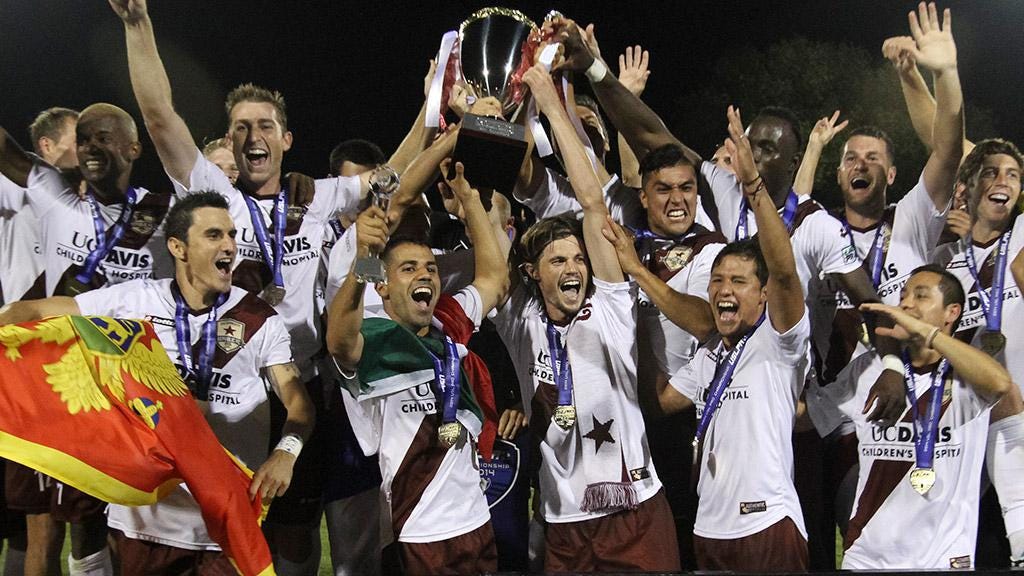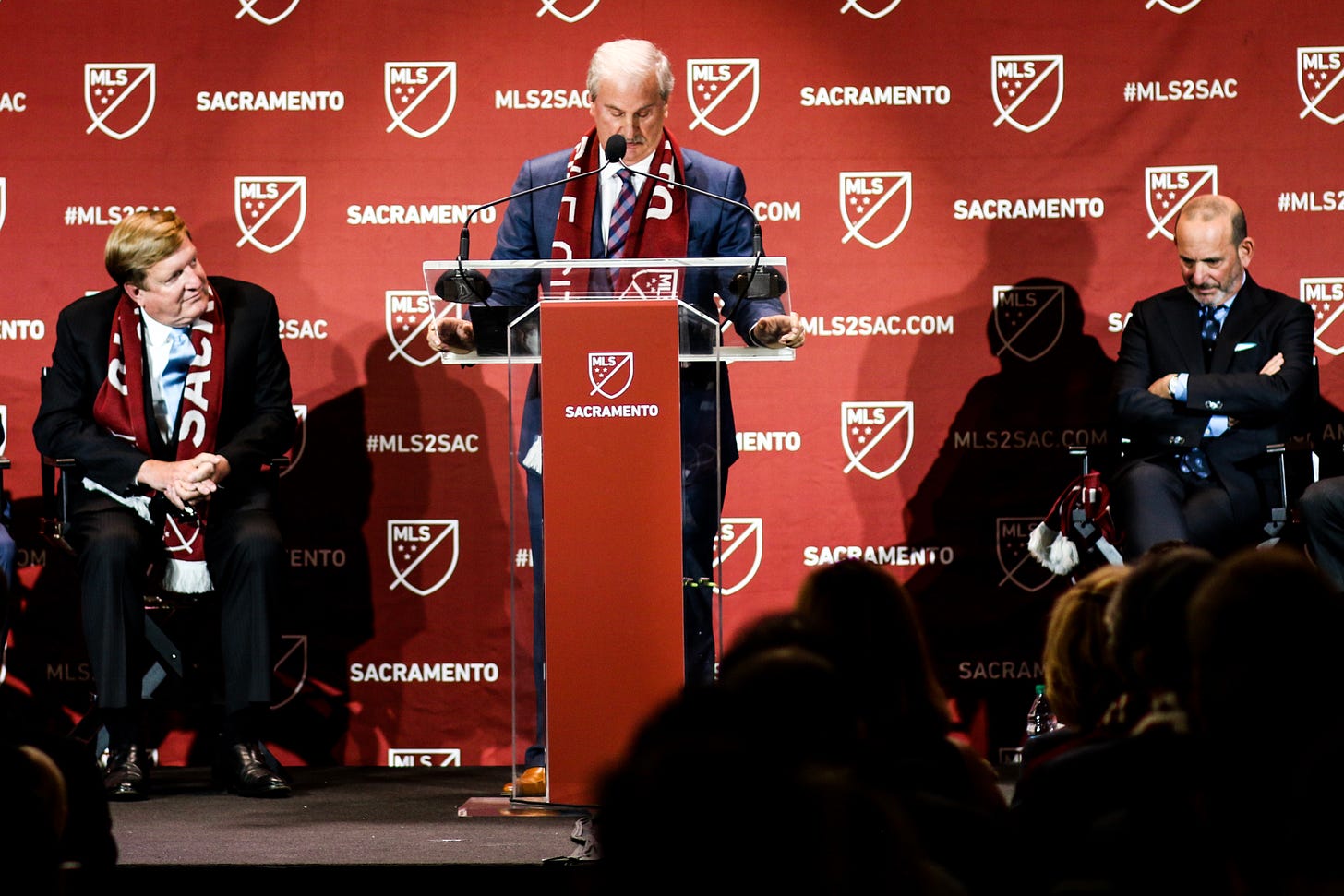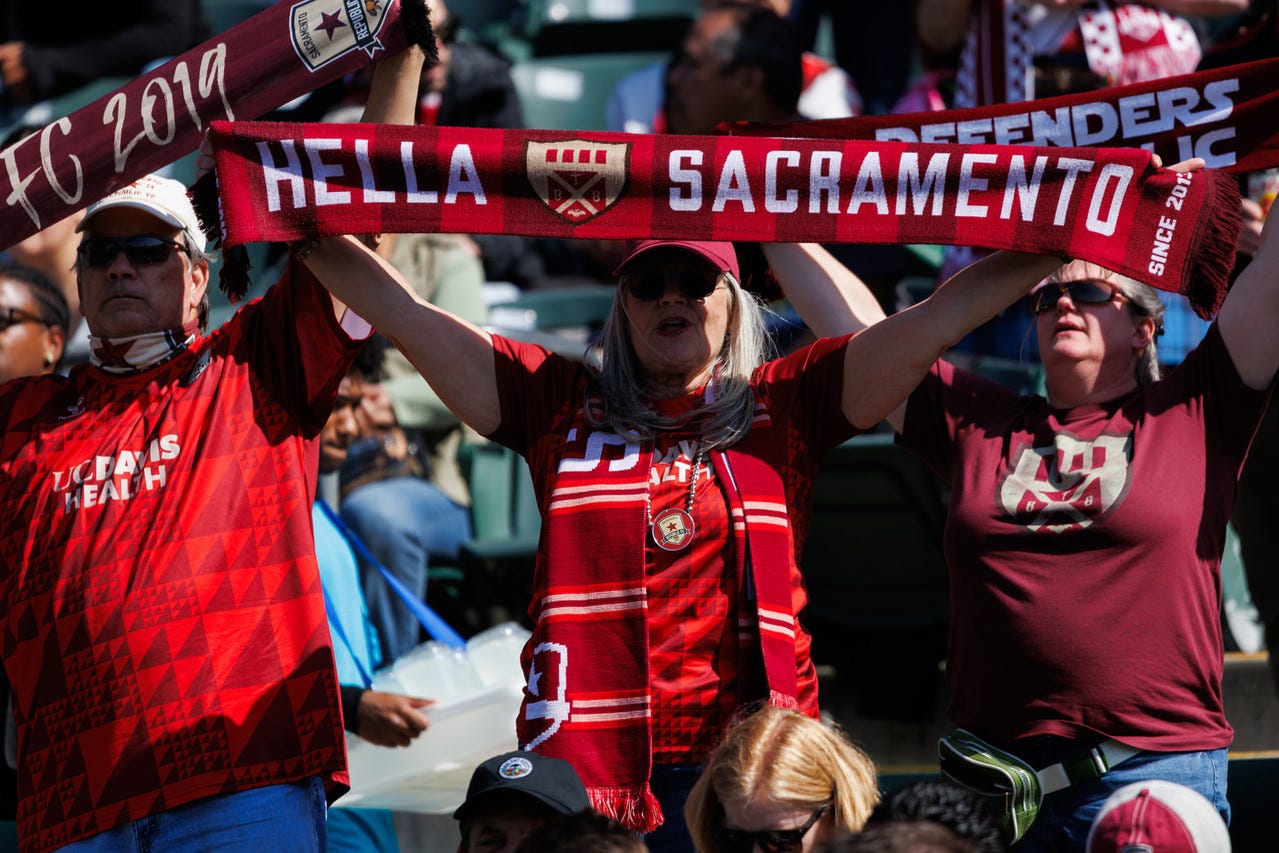Weighing Republic FC's MLS Possibility Against USL’s New Direction
Sacramento’s new stadium and ownership keep MLS hopes alive while USL charts an ambitious Division One future
At the groundbreaking ceremony for Sacramento Republic FC’s new downtown Railyards stadium, a familiar conversation resurfaced—Major League Soccer. The club’s new majority owners, Wilton Rancheria, confirmed they have been in discussions with other California tribes about investing in Republic FC should an MLS bid become a real possibility. That revelation, paired with a Phase 2 construction plan to expand the stadium to 20,000 seats with a full roof structure, suggests MLS remains very much on the table.
For years, Sacramento’s MLS ambitions were thought to be dead, and the club’s future was assumed to rest within the United Soccer League’s growing system. With USL’s planned Division One league set to launch in 2027–28—and the promise of promotion and relegation across three tiers—it looked like Republic FC had found its long-term home. Yet, with ownership now signaling a willingness to revisit MLS, and the stadium’s design clearly leaving room for that leap, both pathways appear potentially in play.
The question, then, is not simply which league Republic FC will join, but which system best matches the ambitions of the club, the city, and its supporters.
What “Division One” actually means in the United States
Before comparing models, it’s worth defining “Division One” in U.S. terms. Under U.S. Soccer’s Professional League Standards (PLS), a men’s Division 1 league must meet specific thresholds, including: at least 12 teams (14 by year 3); 75% of clubs in metro areas of at least 1,000,000; and a stadium of at least 15,000 seats. Teams must also meet ownership net-worth criteria and other operational benchmarks. These are not abstractions; they shape who can play at the top tier and what facilities must look like.
The USL announced in February 2025 that it intends to launch a Division One league in 2027–28, completing a three-tier pro men’s structure (D1, the existing USL Championship at D2, and USL League One at D3). In March 2025, USL club owners approved adopting promotion and relegation connecting those tiers—a first for a major U.S. pro sports competition. Details will roll out over time, but the direction is set.
MLS today: money, platform—and a closed, single-entity model
MLS’s core strengths are obvious: scale, star power, and a media platform that no U.S. rival can match. It runs as a single entity—clubs are technically league-owned and investor-operated—which has historically made cost control and revenue sharing more predictable than in promotion-relegation environments. (It also means rules and roster mechanisms are set centrally).
Two live issues complicate the picture. First, the calendar. MLS leadership has publicly explored moving from its current late-winter-to-fall schedule to a fall-to-spring calendar aligned with most of Europe, with 2027 often cited as the earliest plausible season for a change. As of late July 2025, owners again stopped short of a vote, with the commissioner describing the implications as “seismic”—but they haven’t closed the door. Weather, NFL and college-football conflicts, and broadcast logistics are all factors.
Second, the cups. In 2023, MLS said it would pull first teams from the 2024 U.S. Open Cup—the nation’s oldest ongoing soccer competition—citing schedule congestion and an expanding Leagues Cup, its summertime tournament with Liga MX. After pushback and negotiation, the 2024 Open Cup included eight MLS first teams plus MLS NEXT Pro sides; in 2025, that rose to 16 MLS first teams entering at the Round of 32. The direction of travel is clear: MLS is prioritizing its own competitions (and Concacaf Champions Cup) while limiting Open Cup participation to manage its calendar.
Meanwhile, the Leagues Cup—launched in 2023 with all MLS and Liga MX clubs and a summer league pause—has already evolved. It awarded Champions Cup berths and ran World Cup-style groups in 2023–24; for 2025, it shrank to 36 teams (18 per league) with most matches midweek so domestic leagues can keep playing. Expect MLS to continue optimizing this inventory as it chases audience and revenue.
USL’s vision: an “open” pyramid with promotion & relegation—and its own cup
USL’s pitch is different: an open, club-centric system where merit matters annually. Owners approved promotion and relegation in March 2025, linking three tiers once Division One launches. That is culturally resonant for global soccer fans and could energize local markets with higher-stakes matches across the table.
USL also stood up the inter-league Jägermeister Cup (USL Cup), involving Championship and League One clubs across a group stage and knockout rounds during the league season. The format has been tweaked year-over-year and now runs April to October. For fans, it’s a second knockout competition in addition to the U.S. Open Cup—where USL teams compete regularly and where Sacramento memorably reached the final in 2022, beating three MLS sides along the way before falling to Orlando City.
Facilities & timing: Sacramento’s stadium plan and the PLS
Republic FC just broke ground on a privately financed, 12,000-seat downtown Railyards stadium that the club says is “built for today, designed for tomorrow.” The current configuration can expand to around 15,000 for events, with public reporting and team messaging suggesting future growth potential beyond that. The stadium is targeting a 2027 opening, which happens to line up with USL D1’s expected launch window—and with PLS minimums (notably, 15,000 seats for D1) that would need to be met for a top-tier sanction.
This matters strategically. If Sacramento stays USL and goes for D1 (or earns promotion once the system is live), the facility plan needs to keep pace with those standards. Conversely, if the club were admitted to MLS, the league’s historical stadium expectations and market standards would come into play—though in MLS, those are internal league judgments layered on top of USSF PLS.
Pros & Cons for Sacramento by Path
Pursuing MLS Expansion
Upside
Revenue & reach. MLS offers unmatched visibility in North American soccer. Its Apple TV+ media deal and growing commercial profile provide revenue streams far beyond what USL currently commands. Star-driven narratives—like Lionel Messi’s arrival—boost attendance, global recognition, and league-wide momentum. Showcase events such as the Leagues Cup and All-Star Game further add visibility and sponsorship opportunities.
Roster spend & star power. MLS’s single-entity system and roster mechanisms (Designated Players, U22 Initiative, allocation funds) enable clubs to sign high-profile talent while keeping payrolls in check. This has consistently brought in international stars who elevate both the league and individual clubs.
Competitive ceiling. MLS clubs enjoy guaranteed pathways to the Concacaf Champions Cup and, increasingly, opportunities to qualify for the expanded FIFA Club World Cup. This international exposure can raise the profile of a city and its club in ways no other U.S. league currently guarantees.
Tradeoffs
Closed system. MLS operates without promotion and relegation; membership is fixed and requires a costly expansion slot. Sporting success outside the league does not earn entry, while poor league performance does not carry relegation consequences.
Governance & flexibility. The single-entity model creates stability but limits autonomy. Player contracts and roster rules are centrally controlled, and league-wide decisions—such as a potential shift to a fall-to-spring schedule—may prioritize broader commercial goals over individual club needs.
Cup participation. MLS has limited its involvement in the U.S. Open Cup in recent years to reduce scheduling congestion, a move that has frustrated fans who value the tradition of an open competition where amateur and professional clubs can face each other.
Competitive ceiling—pro and con. While MLS clubs are guaranteed entry into continental and global competitions, USL’s new Division One has not yet clarified whether its clubs will be eligible for Concacaf Champions Cup berths. FIFA Club World Cup access appears unlikely. For Republic FC, MLS provides certainty at the top end, but it also locks the club into a closed system where advancement depends on financial and league decisions rather than on-field merit.
Staying in USL and aiming for D1 with Pro/Rel
Upside
Meritocracy & stakes. A club can climb to the top tier by performance—not by buying in. Every match matters: a promotion push, a relegation escape, or a mid-table battle with Cup implications .
Local identity & control. USL’s club-centric model generally gives teams more autonomy over brand, operations, and community strategy. The Jägermeister Cup adds defined knockout stakes across the season alongside the Open Cup.
Timing with infrastructure. A 2027 stadium opening dovetails with the USL D1 timeline. If expansion planning bakes in a quick path to 15,000+ seats, Sacramento would be positioned to meet sanctioning thresholds when it matters.
Tradeoffs
Market reach & media money. USL’s national platform has grown, but it is smaller than MLS’s. That impacts top-line revenues (media, sponsorship, international brand pull) and player-recruitment gravity.
Execution risk. Launching a new D1 and rolling out promotion-relegation in the U.S. is ambitious. The league must thread PLS compliance (stadiums, ownership thresholds, geography) while keeping club economics healthy. The vision is compelling; delivery will be scrutinized.
What kind of soccer city do we want to be?
This is where reasonable people diverge. MLS has aggressively professionalized the sport in North America, delivered full stadiums, and—through ventures like Leagues Cup—put U.S. clubs on bigger stages more often. The league also tinkers constantly in search of audience. Some fans see that as innovation; others see commercialization that sidelines heritage competitions.
USL’s move to pro/rel, by contrast, is a bet that the American market is ready for global soccer’s core drama: sporting merit decides your tier. If the pyramid connects cleanly and the top tier achieves D1 sanction with strong clubs coast-to-coast, the long-term upside for supporter culture is obvious. But the near term will involve growing pains, capital projects, and a lot of building while playing.
Key Factors in Sacramento’s Decision
Stadium as strategy. The Railyards project is the cornerstone of either path. Opening at 12,000 seats in 2027, the facility will require a near-term expansion to meet the 15,000-seat minimum for Division One sanctioning—and to position the club for MLS consideration. Clear phasing, budget, and permitting for that expansion will determine how quickly Republic FC can scale if opportunity arises.
Aligned timelines. The stadium’s 2027 debut coincides almost perfectly with USL’s planned Division One launch. That synchronicity strengthens the case for remaining in the USL system, but it also preserves flexibility if MLS opens its expansion process in the same window. In either direction, Sacramento will not be left waiting on infrastructure.
Protecting identity. Sacramento’s 2022 U.S. Open Cup run cemented the club’s reputation as a giant-killer and community standard-bearer. Regardless of league alignment, prioritizing the Open Cup is critical to maintaining credibility with supporters and with U.S. Soccer. The city’s soccer identity is tied as much to those knockout nights as it is to league play.
If the priority is maximum national/international reach soonest, with the broadest commercial ceiling and star-driven upside, the MLS path remains the shortest line to that outcome—accepting the tradeoffs of a closed, centrally managed league that will keep optimizing calendars and competitions at the league level.
If the priority is club autonomy, a meritocratic sporting identity, and being part of an open domestic pyramid, then staying in USL and pursuing the new D1—with an aggressive, financed stadium-expansion plan—fits the city’s supporter culture and could deliver sustained stakes year after year. It’s a longer build, with more operational risk—but also a chance to help shape the future of U.S. soccer rather than merely join it.
The Road Ahead
For now, the decision remains unsettled. MLS sits at 30 clubs following the addition of San Diego FC, and while it is widely assumed the league will eventually expand to 32, no timeline has been shared. Sacramento’s name inevitably surfaces whenever expansion is mentioned, but there are no guarantees.
What seems more certain is that Republic FC will be part of the USL’s new Division One when it launches in 2027–28, especially with the Railyards stadium scheduled to open that same year. For supporters and local officials, that would still represent top-flight soccer under U.S. Soccer sanctioning—and a league structure more in tune with global traditions.
Beyond that, the door to MLS remains cracked open. With new ownership showing interest and the stadium designed for future expansion, Sacramento is positioning itself to be ready should an opportunity arise. Until then, the club’s path will reflect both ambition and patience; competing at the highest level available now, while keeping an eye on the possibility of joining America’s most visible league down the road.
Whatever league Republic FC ultimately calls home, one thing will remain constant—the supporters who have carried the club since 2014 will define its identity and future.







Correction: Beat 3 MLS sides in 2022 on the way to the US Open Cup Final. Round of 16; SRFC 2-0 San Jose Earthquakes. Quarterfinals; SRFC 2-1 Los Angeles Galaxy. Semifinals; SRFC 0 (5) - 0 (4) Sporting Kansas City.
First time since 2008 a 2nd division team, Charleston Battery, has reached the US Open Cup Finals. First time since 2005 a 2nd division team, Minnesota Thunder, defeated 3 MLS sides.
As we both know, only the 2nd division Rochester Raging Rhinos defeated 4 MLS sides on their way to winning the 1999 US Open Cup.
Interesting. Will Lucy ever stop taunting us with that football?
A couple of other thoughts:
-Is MLS going to wait for Division 1 to launch and then try to steal the top members (sort like some ABA / NBA merger)? Phoenix, Sacto, Detroit, OC, you're coming with me.
-Is MLS worth the extra cost/effort. It is still noticeably inferior to Euro soccer so what is the premium you are paying for and is it worth it. Do you choose to watch MLS?
-That schedule change could wreak havoc on some teams, especially Minnesota, Toronto, etc. I'm not sure I'd want to go through a winter of soccer TBH.